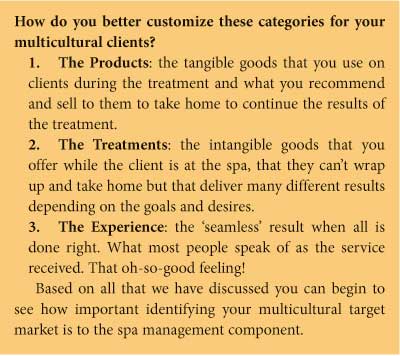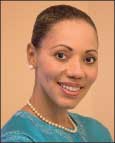A Female Thing
In all American households, it is women who often decide where money is spent, especially on groceries and personal care products, according to experts.
According to New York-based Packaged Facts' "The U.S. multicultural women market" report, the African-American, Asian, and Hispanic female population grew 40 percent between 1995 to 2003. In terms of personal care products, Packaged Facts said ethnic women spend approximately $118 million on ethnic-specific skin care products each year, excluding cosmetics.
"More and more ethnic women are working, attending college, and earning better salaries," explained Don Montuori, acquisitions editor, Packaged Facts, a division of MarketResearch.com. "This is not to say that there's yet parity with non-Hispanic white women, but with the explosive growth in ethnic populations, especially among Hispanic women, the overall trend is for a greater percentage growth in income."
By 2009, The Selig Center, University of Georgia estimates that Hispanics will account for nine percent of consumer spending in the U.S; however, they tend to be thrifty shoppers. Selig's "Consumer expenditure" survey revealed Hispanic consumers spend only about 84 percent as much as non-Hispanic consumers, and about the same amount on personal care products as others.
Steep competition in the marketplace will allow all consumers a multitude of options in choosing products and who they will do business with. It is crucial that salon and spa business owners and managers truly understand the multicultural consumer and their potential, in order to truly maximize one's expansion opportunities. Having a clear vision of who your target market is, their needs, and buying behaviors will give you a head start in developing a business strategy to more than delight and serve this potential client. They will recognize that you truly care about them and they will reward you with their loyalty for years to come.
Not only will it be important to understand the multicultural consumer but it will also be important to understand your business environment; its strengths, weaknesses, opportunities, and threats (SWOT). Through conducting a SWOT analysis, you will be able to take your business' temperature to make sure that you are ready and prepared to take advantage of the multicultural opportunities before you in the marketplace.
Identify Your Business with its Target Market
We all have a vision of who our customers will be when we open our business doors. We have done our due diligence to decide that we have something to offer that the consumer will want to buy. Even if this means that our idea started out with a problem that we had and could not solve. This is where most entrepreneurial business ideas come from.
The challenge is making sure that there are enough customers that can and are willing to buy your product. Your product includes treatments, tangible products, and experiences. With this in mind you must study market trends and focus on how many customers are available and who will be ideal for your business. It is not enough to cast your net and believe that you will and can serve every one; that is too wide a cast. You must focus your scope to truly be successful in your specific service offering.
Since consumers are coming in more shapes, sizes, and colors, we must gain clarity to effectively attract the clients we are looking to serve. Too often I hear people say that they serve every one and this mindset can dilute your real uniqueness and specialty that will differentiate you from the competition and allow you to gain a competitive advantage.
Conducting demographic and psychographic studies will be important as psychographic analysis continues to gain popularity as it is important to understand the activities, interest, and opinions of your potential multicultural clients. All consumers can be fickle at times and this can make it difficult, if not monitored often, to truly determine what the client wants and more importantly needs.
We are all familiar with WIIFM: what's in it for me? This is always on all clients' minds as we are in a "ME" society and telling the client as quickly as possible what you have to offer them and how you offer it will in most cases gain their attention.
Understanding what makes the multicultural consumer tick will allow you to identify the best ways to communicate your message, be it the Internet, direct mailers, print advertisement, or the mixture of these.
Staying close to this consumers' thinking will prove a powerful insight tool for the progressive business person and will also allow you to see things that your clients will need before they even recognize it.
The saying of the day is "Know thy Client". Remember, we are in business to create a customer and keep them. It will be a bit easier if we take the time to get to understand them.
Nothing is sold until the consumer identifies that they have a need and then through the "buyer process" begins the search for a solution. If you can identify with several of the possible problems that the multicultural consumer is concerned with regards to their personal care and lifestyle needs and then decide which ones you have solutions for, you are well on your way to creating a solid and sustainable business.
Based on all of your information gathering you are now in a position to begin developing your multicultural business strategy.
Products to Address the Multicultural Spa Client
Once you clearly understand the needs of your potential multicultural client, you can begin the search and development for key products and treatments. This then will also support the experience you want to provide and the service on which you will provide it.
What is your current offering? What do you need to do to more specifically meet the needs of your potential multicultural client?
Current Offering
- What do you currently offering?
- What is being sold?
- Who is buying it?
- What factors do you need to look at today to determine the changes you must make in your business to more successfully meet the needs of the multicultural clients' wants and desires?
- How can you get your vendors to better assist you in meeting these clients' needs?
- Do your vendors understand the needs of the multicultural client, be they African American, Asian, or Hispanic?
Based on the information that you are gathering, what do you see as the most important aspect of your business right now to further meet these clients' needs?

Food for Thought
Your brand image is a set of beliefs that consumers hold about your particular brand. How does your business connect with your current client and what can be done to reach out to the multicultural market that you want to target? What does your print and Internet marketing material say to this potential client? Do you include photographs of this potential client in your marketing materials? Do you use terminology that will grab their attention? Do you conduct market research to truly understand their specific needs and desires? What classes are you taking to better understand their personal care needs?
Understanding your potential multicultural client's demographics will give you vital statistics about the populations: gender, generational cohorts, ethnic diversity, occupation, income, and education.
Studying the psychographics of your potential multicultural consumer will provide you with the techniques of measuring lifestyles and developing lifestyle classifications; it involves measuring the major AIO dimensions (activities, interests, opinions) of this consumer.
The customer buying process is the stage a customer goes through in purchasing a good or service. As business owners and managers you must clearly understand this process.
Lifestyle retailing is a way to develop your retail format based on a consumer's living patterns. Understanding cultural differences will provide you with the set of basic values, perceptions, wants, and behaviors learned by a member of society from family and other important institutions.
Universal Needs for all Clients
As a human race, we have more similarities than differences. Travel the world and you'll find all women are concerned with maintaining their beauty, health, and wellness.
- All clients want to know that you truly care.
- All clients want to be respected.
- All clients want to know that you are the expert and can truly help them with their particular personal care concerns.
- All clients want to know that you can identify with their specific needs.
- All clients want to know that you continue to educate yourself with the latest advancements and findings that can deliver 'real' results for them.
- All clients want to know that you offer the 'best' treatments and products to meet their individual needs and desires.
- All clients want to know how much you value their business and loyalty.
Skin Care Needs for Clients with Skin Rich in Melanin
It can be a daunting experience to try and meet all the specific needs of the multicultural client just as it can be with your current clientele, but some things are universal.
- Focus on the need for good hygiene for all clients. Talk more about the skin as the largest living organ of the body and its specific needs as an organ.
- Skin rich in melanin will suffer more commonly with hyperpigmentation. Be cautious with treatments that are too aggressive, products with synthetic fragrance, drying alcohol, and any other known irritants.
- Acne prone skin conditions can appear more severe with skin rich in melanin as the skin can be very sensitive and inflammation can be more severe. Post-inflammatory lesions will be more extensive and visible.
- Skin rich in melanin at first glance may appear very tough but just the opposite, it can be very sensitive. You must train your eye and your touch to notice subtle differences. Excessive pressure, temperature, and time can over work the skin and cause further sensitivity.
- Everyone's skin ages, especially with our increased stressful lifestyles and the increased exposure to ultraviolet light. You must pay attention to the areas of the face that can show aging such as the eye area and neck. Clients who have skin rich in melanin may not show signs of aging as quickly as their more fair skinned sisters, but you can notice aging through uneven skin tone, especially around the eye area as the dark circles cause one to look tired.
- Offer products and treatments that work to refresh and brighten the skin instead of using the term "Lightening".
- Hydrate, hydrate, hydrate… skin rich in melanin can be dehydrated and appear "Ashen", causing a gray cast to the skin making it look extremely dull. Good hydration is a must.
Opportunities to attracting a multicultural clientele are vast, profitable and exciting. What you must ask yourself is if you are really interested in attracting this potential client? Are you willing to do what it takes to really learn about the needs of this potential client's personal care needs and desires? Are you willing to build this client's trust? And are you willing to embrace every human being's beauty? If you answer "yes" to all of the above questions, you are well on your way to success.
 Nina Curtis is the founder and president of the Nile Institute, 'A Source Vitál', located in West Hollywood, Calif. and Curtis Communications. Known as the "Aesthetician's aesthetician", Curtis has a 25 plus year history in the professional skin care industry, where she is respected as an innovative skin care specialist, educator, lecturer, and businesswoman. Originally licensed as a cosmetologist, Curtis has obtained certification in Aromatherapy, Reflexology, Acupressure, Energy Modalities, Reiki, and Color Light Therapy. Curtis has trained throughout the U.S, France, Germany, Australia, and England. She received her Bachelor degree of Science in Management and her MBA from Pepperdine University and is also a graduate of the Lynwood Business Institute. For more information, you may contact Curtis via e-mail at This email address is being protected from spambots. You need JavaScript enabled to view it.
Nina Curtis is the founder and president of the Nile Institute, 'A Source Vitál', located in West Hollywood, Calif. and Curtis Communications. Known as the "Aesthetician's aesthetician", Curtis has a 25 plus year history in the professional skin care industry, where she is respected as an innovative skin care specialist, educator, lecturer, and businesswoman. Originally licensed as a cosmetologist, Curtis has obtained certification in Aromatherapy, Reflexology, Acupressure, Energy Modalities, Reiki, and Color Light Therapy. Curtis has trained throughout the U.S, France, Germany, Australia, and England. She received her Bachelor degree of Science in Management and her MBA from Pepperdine University and is also a graduate of the Lynwood Business Institute. For more information, you may contact Curtis via e-mail at This email address is being protected from spambots. You need JavaScript enabled to view it.
